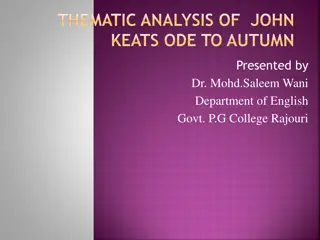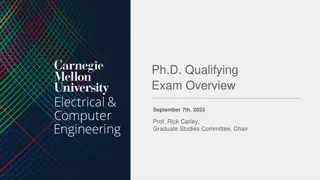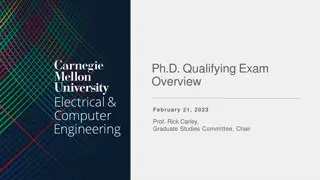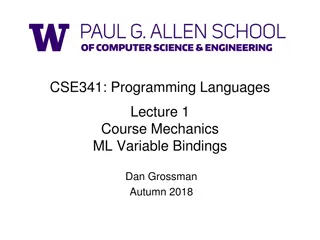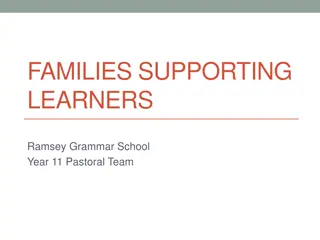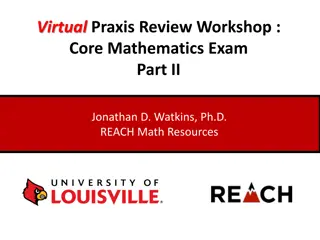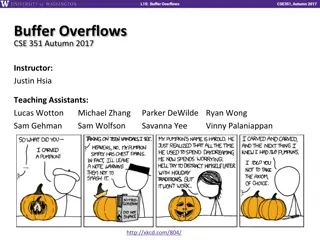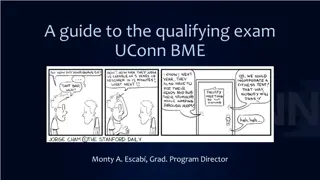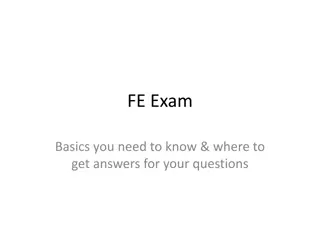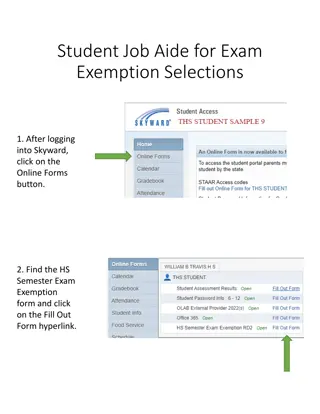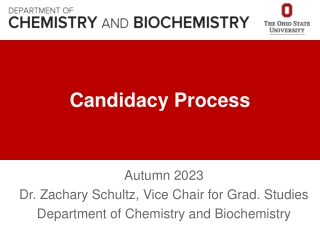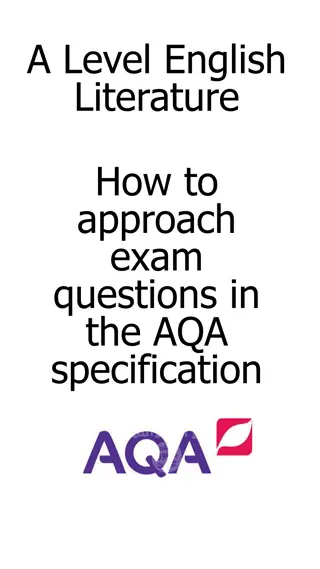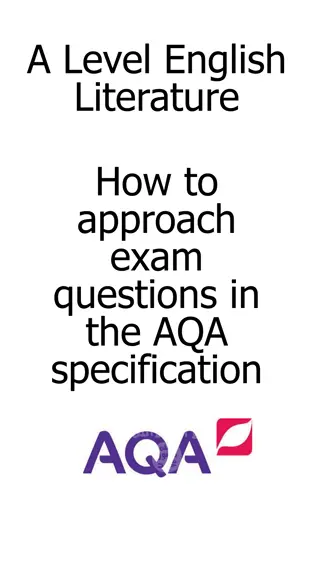Comprehensive Guide to AS and A Level Exam Advice - Autumn 2015
This guide provides detailed information on the AS and A Level psychology exam, covering general information, assessment objectives, assumptions, application to relationships, therapy approaches, and components of therapy. It includes examples from past papers and valuable insights for effective exam preparation.
Download Presentation

Please find below an Image/Link to download the presentation.
The content on the website is provided AS IS for your information and personal use only. It may not be sold, licensed, or shared on other websites without obtaining consent from the author. Download presentation by click this link. If you encounter any issues during the download, it is possible that the publisher has removed the file from their server.
E N D
Presentation Transcript
COMPONENT 1 EXAM ADVICE AS AND A LEVEL Autumn 2015
COMPONENT 1 Page number GENERAL INFORMATION 80 marks for AS, 100 marks for A Level. 1hr 45 minutes for AS, 2hrs 15 minutes for A Level. Each approach will be included at least once. At least one piece of classic evidence will be covered. The last question on the paper will be the contemporary debate.
Component 1 Page number ASSESSMENT OBJECTIVES Description Type of Question Define Describe Outline State Explain AO1 Demonstrate knowledge and understanding Apply Explain AO2 Apply knowledge and understanding With reference to...discuss Evaluate Discuss Compare Analyse Critically assess AO3 Analyse, interpret and evaluate
Component 1 Page number ASSUMPTIONS Examples from the SAMS (a) Describe the biological assumption of localisation of function . [3] (b) Describe the positive assumption of 'focus on the good life . [3] (NB. From WJEC Welsh SAMS) Points to note The 3 assumptions named on the specification must be taught as they could be named in exam paper. Easy to over-teach on this section. Use examples from Psychology. Could use application to a relationship as an example for one assumption.
Component 1 Page number APPLICATION TO A RELATIONSHIP (ANY BEHAVIOUR FOR A LEVEL) Examples from the SAMS Using your knowledge of two different psychological approaches explain how arelationship is formed. [10] (AS Question) Describe the influence of childhood experiences and one other assumption of the psychodynamic approach in explaining human behaviour. [6] Points to note See notes from later session
Component 1 Page number HOW THE APPROACH CAN BE USED IN THERAPY Examples from the SAMS Demonstrate how a cognitive assumption has been used in either cognitive behavioural therapy (CBT) OR rational emotive behaviour therapy (REBT). [10] Describe how the assumptions of the positive approach have been used in eitherQuality of life therapy OR mindfulness therapy. [10] (AS Question) Points to note On previous specification this was required at the start of a therapy answer. It can now be a separate question. Need to explain how the approach would explain psychiatric problems and how this makes the particular therapy appropriate for that approach.
Component 1 Page number COMPONENTS OF THERAPY Example from the SAMs Describe the main components of a psychodynamic therapy (either dream analysis OR group analysis psychotherapy). [8] (N.B. WJEC Welsh SAMS) (a) One principle used in Rational Emotive Behaviour Therapy (REBT) is challenging awfulising beliefs . Identify andexplain one other principle that isused during REBT. [4] (b) One principle used in Cognitive Behavioural Therapy (CBT) is therapy duringtherapy . Identify and explain one other principle that is used during CBT. [4] (AS Question) Points to note Only need to teach one of the two named therapies for each approach Ensure it is clearly explained as a therapy (can be an issue with dream analysis for example) Useful to have specific examples or an example of research that shows the therapy being used in practice
Component 1 Page number EVALUATION OF THERAPY Examples from the SAMs Evaluate the therapy you described in 3(a). [10] (N.B. WJEC Welsh SAMS) Points to note Effectiveness and ethical considerations must be taught as they can be named in exam questions. Effectiveness likely to include specific research studies but bear in mind marks available when considering how many to use and how much detail to go into. Wider issues such as determinism could be used but they must be clearly linked to the therapy being discussed.
Component 1 Page number EVALUATION OF APPROACH Points to note Important to show how the evaluation point links to the approach rather than just generic points. Acronyms to remember evaluation points can be useful but they may restrict more able candidates in the longer answer questions. Although issues and debates can be used as evaluation points there are many other issues that could be considered, for example the use of an effective therapy.
Component 1 Page number EVALUATION OF APPROACH - COMPARE AND CONTRAST Example from the SAMs Compare and contrast the biological approach and the behaviourist approach.[12] Points to note Can use strengths and weaknesses as a framework for this. Need to be careful to compare the approaches and not just describe them.
Component 1 Page number CLASSIC PIECE OF RESEARCH -METHODOLOGY AND PROCEDURES Example from the SAMs Describe the methodology and procedures of Loftus and Palmer s (1974) research Reconstruction of automobile destruction: an example of the interaction between language and memory. [12] Describe the procedures of Raine, Buchsbaum and LaCasse s (1997) research Brainabnormalities in murderers indicated by positron emission tomography . [10] (AS Question) Points to note Accuracy and detail are important here. Stick to information from the original article. Procedure can be written in bullet points.
Component 1 Page number CLASSIC PIECE OF RESEARCH -FINDINGS AND CONCLUSIONS Example from the SAMs Describe the findings of Loftus and Palmer s (1974) research Reconstruction ofautomobile destruction: an example of the interaction between language andmemory . [6] (AS Question) Points to note Accuracy and detail are important here. Stick to information from the original article. Can be written in bullet points. Tables can also be used for findings.
Component 1 Page number CLASSIC PIECE OF RESEARCH -EVALUATION OF CLASSIC EVIDENCE Examples from the SAMs Analyse and evaluate Raine, Buchsbaum and LaCasse s (1997) research Brain abnormalities in murderers indicated by positron emission tomography in relation to the ethical issues and social implications. [16] Evaluate the ethical issues of Watson and Rayner s (1920) study Conditionedemotional reactions . [10] (AS Question) .
Component 1 Page number CLASSIC PIECE OF RESEARCH -EVALUATION OF CLASSIC EVIDENCE Points to note Ethical issues and social implications must be taught as they can be named in exam questions (A Level only). Other evaluation points can be enhanced using alternative evidence but this is no longer a requirement of the specification. Acronyms to remember evaluation points can be useful but they may restrict more able candidates in the longer answer questions.
Component 1 Page number LONGER ANSWER AO3 QUESTIONS Examples from the SAMs Analyse and evaluate Raine, Buchsbaum and LaCasse s (1997) research Brainabnormalities in murderers indicated by positron emission tomography in relation to theethical issues and social implications. [16] Compare and contrast the biological approach and the behaviourist approach. [12] Points to note Students will be required to include a conclusion in their answer to access the highest marks. Answers need to show both sides of the argument (strengths/weaknesses or similarities/differences).
Component 1 Page number AO2 QUESTIONS Points to note These questions will involve the application of knowledge to a novel scenario. They will allow candidates to display their understanding of content rather than simply repeating what they have learnt. Examiners will be mindful of the fact that these questions cannot be prepared for in the same way as some of the others and this will be reflected in the mark scheme. Quotes or any stimulus material need to be referred to in the answer.
Component 1 Page number THE CONTEMPORARY DEBATE QUESTION Points to note Always the last question on the paper. An even split between AO1 and AO3 skills. The answer should show both sides of the debate. Arguments should be backed up by research evidence. Political evidence can be used for example but clear links must be made to the debate. Any criticism of research methods should be linked back to the debate. Although the debates are linked to particular approaches, material can be drawn from other approaches as well. An appropriate conclusion should be drawn.
Component 1 Page number THE CONTEMPORARY DEBATE QUESTION DEBATES The ethics of neuroscience The mother as a primary caregiver of an infant Using conditioning techniques to control the behaviour of children Reliability of eyewitness testimony Relevance of positive psychology in today s society
Component 1 Page number TACKLING THE CONTEMPORARY DEBATES How is the question marked? An even split between AO1 and AO3 skills What do we expect to see in an answer? AO1 a range of well chosen examples that are accurate and detailed. Technical terminology will be used. AO3 a thorough discussion that uses evaluative comments and considers both sides of the debate in a logical structure. There will also be a conclusion.
Component 1 Page number DON T DO Make sure that all evidence is accurate and relevant Use evidence that is not relevant to the debate Use generic evaluation points that are not specifically related to the argument e.g. this evidence is reductionist without explaining how that affects the debate as a whole Link evidence explicitly to the debate to create two sides of an argument Include a conclusion that adds new information or uses the evidence to make a new statement Repeat yourself in a conclusion so that you are merely repeating points for which credit has already been applied Draw mini-conclusions about the debate by considering ethical, economic and social implications
Component 1 Page number DEBATES - POSSIBLE STRUCTURE Introduction what is at the core of the debate? Why do we care? Evidence for one side of the debate e.g. named psychological study Counterargument e.g. methodological issues with research and implication this has for the debate as a whole Evidence for one side of the debate e.g. how research is applied to improve lives (topic in context e.g. mindfulness in schools for positive psychology) Counterargument e.g. ethical and/or economic implications Evidence for one side of the debate e.g. additional named research or psychological theory Counterargument e.g. social implications of the debate Conclusion which side of the debate is stronger? What new evidence do you have to back this up?
Component 1 Page number EXAMPLES FROM THE SAMS 'Mothers should stay at home for the first two years of their babies lives . Discuss to what extent you agree with this statement. You should demonstrate your knowledge and understanding of psychological ideas and processes in your response. [24] It is important that children are both punished for wrong doing and praised when good to ensure that they learn the correct ways to behave . With reference to psychological knowledge, discuss to what extent you agree with this statement. [20] (AS) Neuroscience has many positive applications in contemporary society; however the ethical implications are debatable . Discuss. [20] (N.B. WJEC Welsh SAMS)




